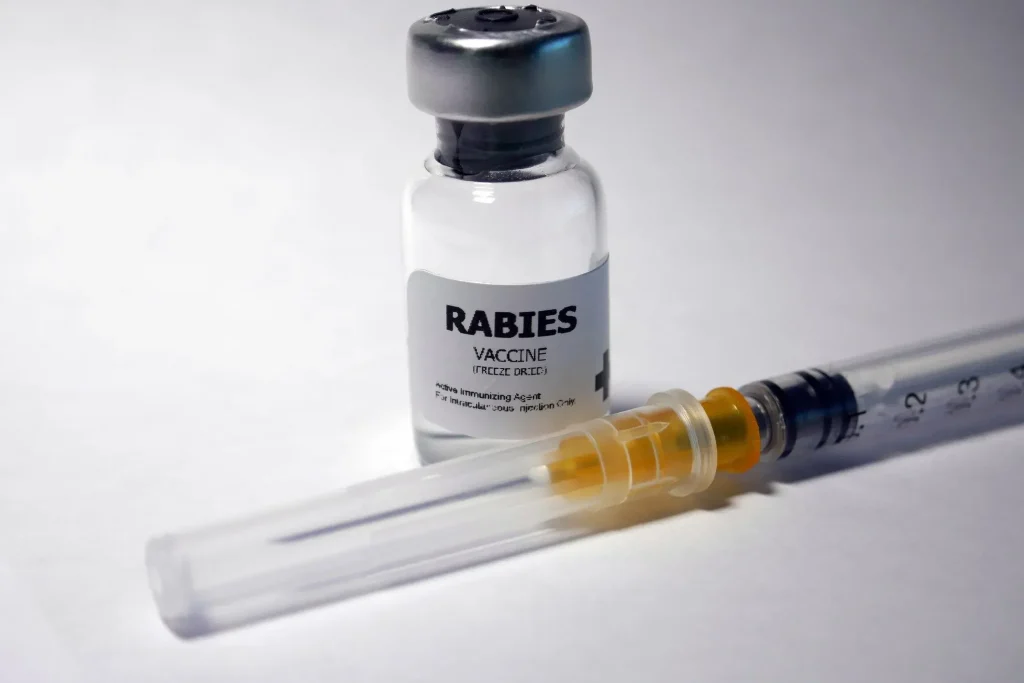Rabies shots are crucial in protecting individuals from the potentially deadly virus that can be contracted through exposure to infected animals, such as bats. A shocking incident involving Alison Doyle from Montréal highlights the urgency of rabies treatment when she discovered a dead baby bat in her toilet accompanied by a mysterious scratch on her leg. After her alarming revelation went viral on TikTok, she received an outpouring of advice from concerned viewers, urging her to seek medical attention immediately. Rabies symptoms, which can take weeks or even months to manifest, emphasize the importance of prompt action—especially after a bat scratch. For those at risk, urgent care for rabies is vital to ensure effective treatment and avoid the grim outcome that rabies typically entails once symptoms appear.
Vaccination against rabies is essential for anyone who has been potentially exposed to the virus, particularly in situations involving wildlife encounters. In Alison Doyle’s case, her unexpected finding of a bat in her home led to a swift recommendation for rabies shots after she noticed a scratch on her leg, sparking an urgent response from social media users. The critical nature of rabies treatment cannot be overstated, given that the disease remains almost invariably fatal once clinical signs develop. This underscores the importance of swift medical intervention and the role of emergency services in providing rapid access to rabies vaccinations. For anyone worried about exposure, understanding the signs and seeking hospital emergency care can be life-saving.
Urgent Care for Rabies: What to Do When You Suspect Exposure
When a bat is found indoors, especially in your home, it’s important to consider the possibility of rabies. This viral infection is commonly transmitted through bites or scratches from infected animals, and while a single scratch may seem minor, it can pose a serious health risk. If you or someone you know has come in contact with a bat or any other potentially rabid animal, it’s crucial to seek urgent care. Immediate attention from medical professionals can significantly reduce the risk of developing rabies, which is invariably fatal once symptomatic.
In the case of Alison Doyle, her experience serves as a cautionary tale about the importance of swift action. After discovering a dead baby bat and realizing she had a new scratch on her leg, the urgency of visiting a hospital was underscored. With the comments on social media urging her to go for treatment, Alison highlighted how vital it is to regard any signs of potential exposure seriously. Rabies treatment often begins with post-exposure prophylaxis, which includes a series of rabies shots. This prevents the virus from establishing itself in your system, thus averting a potentially fatal outcome.
Understanding Rabies Symptoms: Early Detection Saves Lives
Recognizing the symptoms of rabies is crucial for anyone who might be at risk. Rabies symptoms can start with mild flu-like signs, but they quickly escalate to severe neurological issues that can include hallucinations, anxiety, and paralysis. Though symptoms typically may take weeks or months to develop after exposure, they can also appear quite abruptly, underscoring the need for vigilance following a possible rabies encounter. For individuals like Alison, awareness of these symptoms is a key factor in seeking timely medical care.
The challenge with rabies is that the window for effective treatment closes rapidly once symptoms begin to appear, making early detection and response paramount. The knowledge that symptoms can take anywhere from three weeks to several months to manifest could lead to a false sense of security for some, leading them to delay seeking medical help. Communities and health authorities emphasize the importance of education on rabies symptoms and preventive measures to help mitigate any outbreaks. In Alison’s case, the immediate concern for rabies symptoms following her bat encounter was a crucial part of her story, prompting her to continue her hospital visits for treatment.
The Importance of Rabies Shots After Animal Encounters
Rabies shots are your best protection against this lethal virus if you’ve been exposed to a rabid animal. Following a potential exposure, such as a bat scratch, getting rabies shots is vital to ensure that you do not contract the disease. The rabies vaccine, specifically designed to stimulate your immune system, helps your body fight off the virus before it can establish an infection. In Alison’s recounting of her hospital experience, she highlighted the importance of these shots, noting that she would need multiple doses over several visits.
The concept of rabies shots can sometimes be intimidating or misunderstood. Many individuals fear needles or worry about side effects, but the benefits far outweigh the temporary discomfort. The rabies vaccination is a life-saving measure that not only prevents the disease from taking hold but also gives peace of mind. Hospitals typically have protocols in place for handling potential rabies cases, including education about the treatment regimen and monitoring for any adverse reactions, ensuring that patients like Alison receive prompt and effective care.
Hospital Emergency Visits: Navigating the Process for Rabies Treatment
Visiting the hospital can be a daunting experience, especially for those with anxieties about medical environments, as expressed by Alison in her videos. She detailed her reluctance to seek care due to the long wait times often associated with hospital emergency departments in Canada. However, the seriousness of potential rabies exposure necessitates prioritizing health over personal comfort. Knowing what to expect can help alleviate some of this anxiety, allowing individuals to focus on getting the necessary treatment.
Emergency departments are equipped to handle situations involving potential rabies exposure. Upon arrival, patients are typically assessed quickly, and if rabies shots are deemed necessary, they will be administered as soon as possible. This crucial first step in treatment can vastly improve outcomes for those exposed to rabies. Alison’s story not only sheds light on the importance of understanding the protocol in emergency settings but also encourages others to seek care when faced with similar potential threats to their health.
Dealing with Bat Encounters: What You Need to Know
Finding a bat in your home can be a shocking experience, as it was for Alison when she discovered the tiny creature in her toilet. Understanding the risks associated with bat encounters is essential. Bats, while beneficial to the ecosystem, can carry rabies—a fact that requires a cautious approach when they are found indoors. If you encounter a bat and suspect possible exposure through a scratch or bite, acting swiftly is imperative. Avoid direct contact and try to secure the area before seeking professional help.
Education on how to respond to bat encounters can help mitigate fear and ensure safety. Following the proper protocols when discovering bats, such as calling animal control or wildlife services, can prevent exposure to rabies and other health risks. Alison’s experience resonates with many others who may find themselves in similar situations, emphasizing the need for awareness and preparation when dealing with bats. Her story serves as a reminder that prompt action and awareness of rabies protocols can save lives.
The Role of Social Media in Health Education: Lessons from TikTok
Alison’s experience doesn’t just highlight the risks of rabies; it showcases the power of social media in disseminating health information. Her TikTok videos quickly garnered attention, leading to a flood of comments urging her to seek rabies treatment. This rapid response from the online community played a significant role in her decision to go to the hospital. Social media can be a double-edged sword, at times providing valuable support and information that leads to positive health outcomes, as seen in Alison’s case.
Moreover, the discussion surrounding rabies prevention and treatment on platforms like TikTok can help raise awareness of the seriousness of the disease. Users sharing their experiences or providing guidance can turn personal anecdotes into broader public health messages. In Alison’s follow-up clips, she not only educates her followers about the importance of rabies shots but also invites a conversation on medical anxieties and the health system. Her platform serves as a contemporary means of engaging the public in discussions about health and safety.
Learn About Rabies Prevention: Key Takeaways
Prevention is always better than cure, particularly with dangerous infections like rabies. Understanding how to prevent rabies exposure involves not only logistical preparation, such as securing areas where bats or wild animals can enter, but also being informed about vaccination protocols for pets and wildlife. Regular rabies vaccinations for pets can significantly reduce the risk of rabies transmission to humans, therefore reducing the chances of potential exposure in cases of animal interactions.
In addition to pet vaccinations, educating oneself—and your family—about the behavior of local wildlife can be integral to prevention. Knowing how to handle encounters with bats, raccoons, foxes, or other potentially rabid animals is vital. The lessons narrated through Alison’s TikTok account convey this importance effectively, prompting viewers to take proactive measures regarding rabies prevention. Simple actions can lead to substantial changes in community health and safety.
Bats and Rabies: Exploring the Connection
Bats are often cited as one of the primary reservoirs for rabies, which makes their presence in residential areas particularly concerning. While not all bats carry the rabies virus, the risk of encountering an infected bat heightens the need for vigilance. Education surrounding bat behavior and habitat can help individuals avoid unwanted encounters, reducing the fear associated with these creatures while keeping communities safe from rabies cases. Understanding why bats may enter human spaces can guide individuals in creating uninhabitable environments for them.
The relationship between bats and rabies is multifaceted—a biological connection—but also a societal concern. Awareness campaigns that shed light on healthy wildlife interactions can foster an environment that respects natural fauna while prioritizing community safety. As Alison’s story went viral, it sparked conversations around the necessity of rabies awareness, tying in the ecological role of bats and the potential health implications for humans. This intersection of wildlife and health speaks volumes to integrated community education efforts regarding rabies.
Rabies Statistics: A Closer Look at Public Health Risks
Statistics surrounding rabies are stark and underscore the disease’s severity. Each year, thousands of humans succumb to rabies globally, primarily due to exposure from unvaccinated animals. Knowing the statistics can engender a sense of urgency in communities regarding rabies awareness and prevention. Even in developed countries, the risks remain present, particularly with wildlife interactions. As highlighted by Alison’s recent experience with a bat, underlying public health challenges are often neglected until an incident occurs, emphasizing the need for continuous public health education.
Furthermore, rabies statistics reveal a pattern of reporting and awareness that can influence policies and health interventions. Countries with high rabies transmission rates often see targeted awareness campaigns, primarily focusing on vaccination and education for communities at risk. The impact of such policies can be seen through improved response times and reduced rabies exposure incidents. Alison’s case, alongside others, can drive home the message of vigilance, proper medical response, and the critical need for public health initiatives to address this preventable but deadly disease.
Frequently Asked Questions
What should I do if I discover a dead bat and suspect a rabies exposure?
If you discover a dead bat, especially if you find a scratch or bite on your body, it’s crucial to seek immediate medical attention for rabies shots. Rabies is a serious virus that can be almost always prevented if treated promptly after exposure.
Can a scratch from a bat lead to rabies?
Yes, a scratch from a bat can lead to rabies if the animal is infected. It is essential to get rabies treatment as soon as possible if you suspect exposure, regardless of how small the scratch may be.
What are the symptoms of rabies I should watch for after a bat encounter?
Symptoms of rabies can include hallucinations, anxiety, paralysis, and numbness or tingling at the site of the scratch or bite. These symptoms can take anywhere from a few days to several months to appear, underscoring the importance of timely rabies treatment.
How many rabies shots are needed after potential exposure?
Typically, individuals require two or more doses of the rabies vaccine after potential exposure. If it’s someone’s first time receiving rabies shots, an additional medication called immunoglobulin may be administered.
Where can I go for urgent care for rabies treatment?
For urgent care related to rabies treatment, go to the nearest hospital emergency department or urgent care center. They will evaluate your risk and provide the necessary rabies shots to help prevent infection.
Is it safe to wait if I find a bat and have a scratch?
No, it is not safe to wait if you find a bat and have a scratch. Immediate medical attention is essential to receive rabies shots before symptoms develop, as rabies is nearly always fatal once they appear.
Can rabies be transmitted between people?
Rabies is not transmitted between people; it is primarily contracted from animal bites or scratches from infected animals. Therefore, it’s vital to manage exposure risks from animals immediately.
What did Alison Doyle experience after finding a bat related to rabies shots?
Alison Doyle experienced alarm upon discovering a dead baby bat in her toilet and a scratch on her leg, leading her to seek rabies shots after community encouragement on TikTok, illustrating the importance of awareness and prompt action in such situations.
How does rabies treatment work following an animal encounter?
Rabies treatment typically involves a series of vaccinations administered after potential exposure. The rabies vaccine can prevent the virus from developing if given promptly, demonstrating the need for immediate action upon exposure.
| Key Point | Details |
|---|---|
| Discovery of Bat | Alison Doyle found a dead baby bat in her toilet and shared it on TikTok. |
| Potential Exposure | She noticed a scratch on her leg which led to worries about rabies. |
| Rabies Awareness | Viewers urged her to get immediate medical help due to rabies risk from bats. |
| Hospital Visit | Alison went to the ER, and her experience highlighted the long waiting times. |
| Clarification on Rabies Shots | She was informed she would need to return for multiple rabies shots after her initial visit. |
| Importance of Rabies Vaccination | Rabies is often fatal without treatment, making vaccination critical after exposure. |
Summary
Rabies shots are crucial for anyone who may have been exposed to the rabies virus, as demonstrated in Alison Doyle’s alarming experience after discovering a bat in her toilet. The potential for rabies infection drives the necessity for prompt vaccination, which can prevent the onset of this nearly always fatal disease. Alison’s story serves as a stark reminder to take immediate action after any encounter with bats or unknown animals, and highlights the importance of awareness and education regarding rabies prevention.



